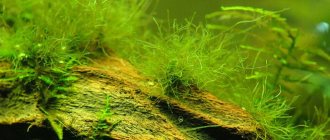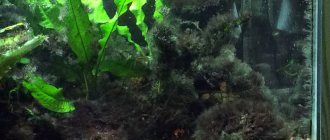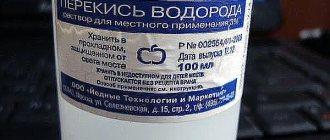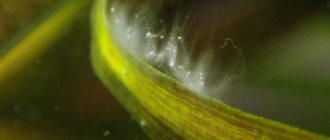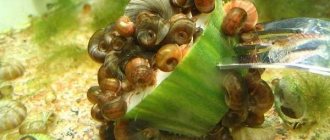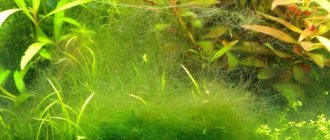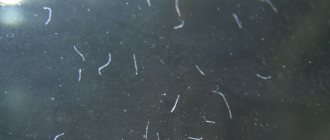Every aquarist encounters algae, which only complement the interior of the aquarium (its decorations look even more realistic). But if seaweed in excess, it not only violates aesthetic proportions, but also causes harm to aquarium plants and fish. Algae can cover glass aquarium, as well as the driftwood and stones contained in it. Fortunately, there are many ways to normalize aquarium flora. Algae in an aquarium: how to get rid of, fight and prevent their occurrence in the future? This will be discussed in more detail in this article.
Algae in an aquarium - how to get rid of it, how to fight it?
Description
In reservoirs with an established biological environment, weeds are present in small quantities. It is worth worrying when faced with their rapid growth. Often a green coating appears on the walls of the aquarium, methods of combating which are discussed in a separate article. To combat lower vegetation in an aquarium, it is important to identify the type of algae. This way you are guaranteed to get rid of parasitic flora and not harm other inhabitants of the reservoir.
Why are plants needed in an aquarium?
These plants have many options:
- Fish food;
- Spawning area;
- Saturation of water with oxygen;
- Shelter for certain types of fish and underwater inhabitants;
- Reducing the “parasitic” population.
The presence of such plants greatly simplifies the care of the aquarium. However, this is not an integral part of aquarium life. Many people plant plants just to fill voids and add flair to the design.
When choosing plants, you need to take into account the behavior of the fish. So, the same plant is not suitable for different types of fish. They will either eat it or get poisoned.
Amateur aquarists are better off starting with easy-to-care plants.
Titles:
- Lemna (duckweed or herbaceous perennial).
- Vallisneria (vallisneria).
- Elodea (elodea).
- Ceratophyllum (hornwort).
- Limnobium (limnobium) and others.
The main thing is to choose those plants that underwater inhabitants will get along with.
Lemna
Vallisneria
Elodea
Ceratophyllum
Limnobium
Reasons for appearance
- Violation or absence of biobalance. If there is a high level of organic matter in the aquarium (rotted grass, uncollected grass, fish waste and leftover food), the weeds have many food sources. Excess organic matter occurs due to overcrowding, infrequent aquarium maintenance and overfeeding of fish.
- Excess or deficiency of phosphorus and nitrates. Higher flora cannot cope with excess fertilizer, so phosphates and nitrates are consumed by algae. And also the lack of nutrients creates a favorable environment for weeds.
- Excess or lack of light. With long daylight hours, lower greenery absorbs excess light, and the plants weaken. The lack of light, in turn, creates conditions for the proliferation of some weed species.
- Incorrect lamp spectrum. Higher flora needs light in the blue and red spectrum. Weeds love the warm yellow light that incandescent lights and sunlight provide.
Biological balance
Achieving complete biobalance is difficult, but possible. Normally, a reservoir, like a large natural reservoir, must maintain the circulation of substances. All dead remains must be broken down by beneficial bacteria and reduced to substances that can be consumed by plants, then produce energy through photosynthesis and again produce biological matter - most often starch and saccharides. Next, the fish eat the plants, digest them, build their bodies from amino acids, produce waste, and the process begins again.
Nitrifying bacteria are responsible for this balance. We will not fully describe the processes produced by these microorganisms: it is so complex that it deserves a whole series of articles. In nature, everything is harmonious, so the balance is established by itself, our task is just not to disturb it inadvertently or intentionally.
Brown or diatoms
Brown algae appears as plaque on the walls of the aquarium, leaves and soil. Harmless to flora and fauna. They often appear in the aquarium of beginners due to unstable biobalance and lack of light. Aquarium algae thrives in hard water with a pH above 7.5. To prevent growth, replace the bulb with a more powerful one or add another light source. If you don’t wipe off the brown plaque, it will form a thick layer that is difficult to deal with.
All types of algae and the fight against them, photo
Algae is not all that grows in water. This is the name given to lower, primitive photosynthetic organisms, often consisting of one cell or several cells collected in colonies or threads. They live everywhere in the aquatic environment. They are distinguished from higher plants by the absence of developed organs: stems, leaves, flowers, and also by the fact that throughout their history they lived exclusively in water, while plants formed on land, and only after that some of them returned to the water .
Why do algae sometimes take over the aquarium?
The laws of nature are such that living organisms settle wherever suitable conditions exist for them. The main thing that algae need for life:
- water;
- light;
- nutrition (macroelements).
Obviously, all this is present in any aquarium.
Algae compete with flowering plants for light and macroelements. Since the latter are more complex and highly organized, under favorable conditions they win this competition, restraining the growth of their more primitive microscopic ancestors, depriving them of nutrition.
However, those are older, more cunning, more resilient, patient and less demanding. These, of course, are not properties of their character, but features of biology. Algae can form various types of spores and other structures that can survive unfavorable times, they require lighting of a different spectrum, and they have different, faster methods of reproduction. And if the conditions in the aquarium are not ideal for higher flora, there will certainly be a scarlet, diatom or cyanobacterium that will not hesitate to take advantage of this.
There are several divisions of algae that have different colors depending on the pigments they contain. Next, we will describe what representatives of different departments look like in the aquarium and what conditions cause outbreaks in their numbers.
Blue-green (cyanobacteria)
Their cells do not have nuclei, so these organisms stand apart among algae. In fact, they are bacteria that have acquired the ability to photosynthesize (during which, with the help of light energy, sugars are formed from water and carbon dioxide in living cells). Despite their low position on the evolutionary ladder, these creatures are extremely tenacious and flexible, and the harm they can cause to an aquarium cannot be overestimated.
Cyanobacteria form mucous, dark green or bluish films covered with large gas bubbles on the walls of the aquarium, soil, plant leaves, and decorations. All this beauty (and there really is something bewitching, alien in this spectacle) draws in the artificial reservoir with incredible speed, emitting a noticeable stench. An outbreak of these organisms can greatly harm plants and fish even in natural conditions (cyanobacteria are the main cause of water blooms in the summer heat), but in an aquarium it is simply a disaster that must be dealt with urgently, and not for the sake of restoring external attractiveness, but to save fish from death.
The reason for the uncontrolled reproduction of blue-greens is a general failure of the ecological balance, which is caused by a high concentration of organic matter in the water, as well as nitrogen and phosphorus compounds due to systematic overfeeding of fish, irregular cleaning, or the death and decomposition of one of the fairly large inhabitants of the aquarium.
Often the situation is aggravated by an insufficient amount of oxygen in the water, its alkaline reaction and high temperature.
Red algae
(Rhodophyta) - bushy multicellular aquatic plants of dark gray, dark purple, olive or reddish color. Otherwise, they are also called scarlet mushrooms; they grow mainly in the seas, but about 50 species are found in fresh water. The worst enemy of aquarists has become Compsopogon, which looks like dark gray bushes up to 5 cm in size. They tenaciously cling to glass, driftwood, and leaves. By multiplying quickly, compogon spoils the appearance of plants. Among aquarists, the plant received the apt nickname “black beard”. Red algae thrive in water with high temporary hardness because they can extract carbon dioxide from bicarbonates.
Diatoms (brown) algae in the aquarium
Diatoms are single-celled organisms with a silicon shell in the form of a box; many of them are capable of movement. The importance of diatoms in natural marine ecosystems is simply colossal, since they make up a significant proportion of plankton and form a huge part of the organic matter of the earth (about a quarter), and their shells, after dying, are the basis of sedimentary rocks.
But in artificial reservoirs they, like their counterparts from other departments of lower plants, are unwanted guests. Brownish or brown algae in the aquarium that form a slimy coating, especially in poorly lit areas, often near the bottom - these, as a rule, are diatoms. (By the word brown, we mean exclusively the color, and not the systematic affiliation, since brown algae themselves are a separate department of highly developed marine organisms with large thallus bodies).
The development of some diatoms almost always occurs in the first weeks after starting a new aquarium. In long-standing aquariums, diatoms appear in conditions of insufficient - weak and short-term - lighting or light of the wrong spectrum, without a blue and red maximum.
Their reproduction is facilitated by a pH above 7.5, high water hardness and a high concentration of nitrogen compounds. An outbreak of diatoms can be caused by an excess of sodium salts in the water, which occurs, for example, after treating fish in a community aquarium by adding table salt.
Black beard
This type of algae (although several species are understood under this name) is one of the most disliked by aquarists, since it is very difficult to control. At first, these algae cover the edges of slow-growing plants, like Anubias, or grow in small clumps. Then they cover all the plants in the aquarium, giving it an unsightly appearance. They pose no danger to fish.
It is almost impossible to remove these algae mechanically. In principle, you can fight them with darkening or chemicals, but then they will grow again. Some fish (siamese algae eater, for example) supposedly eat it, provided they are not fed anything else.
Other types of algae (filamentous, etc.)
These algae come in many types (hair algae, thread algae, etc.). Hair algae, bright green, grows on tufts of soil, stones, etc. Easily removed mechanically or eaten by algae-eating fish. Thread algae, dark in color, grows in long individual threads. It is easily removed mechanically and usually serves as an indicator of excess iron in water (0.1-0.2 mg/l).
Algae growing in small islands on the glass is considered normal for a planted aquarium and can be easily controlled by scraping (be careful if you have a plexiglass aquarium) with a razor or a special scraper. This usually needs to be done on the front glass. Fish such as ancistrus etc. will help keep the glass clean.
What chemical control agents exist and why are they bad?
There are several chemicals available to control algae. Most of them are adapted from fish farming, where it is necessary to deal with overgrowing of ponds. An example is simazine, produced under various brands for aquariums.
Unfortunately, these drugs act differently on different algae and are not always effective. In addition, these drugs also have a negative effect on plants, causing the death of some plants. Such as cabomba or wallinsneria, in the case of using simazine, which affects the process of photosynthesis.
The main disadvantage of these drugs is that they do not eliminate the causes of algae (excess nutrients for algae in the water) and, accordingly, they will appear again from spores. The use of these products may be recommended as a last resort in cases where it is necessary to quickly get rid of algae and then continue biological control, as described below.
Other methods include disinfecting plants in bleach. Some people use hydrogen peroxide to combat certain types of algae.
Lighting adjustment
It is necessary to shift the lighting parameters in a direction that is inconvenient for algae and convenient for plants. In the case of scarlet beetles and diatoms, the intensity and duration of illumination must be increased by more carefully selecting lamps or installing additional ones. The peaks of the lamps should fall in the blue and red regions of the spectrum. In the case of strong development of chlorophyte fouling, the intensity of light and the duration of the photoperiod, on the contrary, are reduced.
When water blooms or an outbreak of cyanobacteria, the lamps are completely turned off for several days, sometimes the aquarium is additionally covered with cloth or paper so that even scattered sunlight and room light cannot reach it. Higher plants will survive this (except for the most delicate ones, which are best put in another container for now), and the algae will die.
Nutrients
To suppress the growth of lower algal flora in the aquarium, it is necessary to maintain a balance of nutrients. There should be as little dissolved organic matter in the water as possible, and macroelements (nitrogen and phosphorus compounds) should be sufficient, but not excessive. This requires regular cleaning of the aquarium, siphoning the bottom, changing water at a rate of a quarter or a third per week, depending on the density of the aquarium population.
A lack of nutrients in an aquarium is less common than an excess of them, and is usually observed in herbal gardens with a very high planting density and a small animal population. In such situations, the issue is resolved by applying fertilizers, and they must be placed in the soil, directly to the roots of the plants. Easy-to-use and affordable aquarium tests can accurately measure the concentration of various compounds in water.
Carbon dioxide
Adding CO2 to the aquarium through various devices provides the plants with a source of carbon and, in the presence of good lighting, can significantly change the balance of power in their favor. In addition, carbon dioxide acidifies the water, which also usually has an adverse effect on the lower flora and a beneficial effect on the higher one.
In addition to these basic measures aimed at improving conditions for plant growth and normalizing the general situation in the aquarium, the following are used to combat algae:
- mechanical removal of them from surfaces using a scraper or toothbrush;
- introducing algae-eating fish into the aquarium (Otocinclus are effective against diatoms, SAE against purpurea and filamentous chlorophytes, Labeo and Gyrinocheylus - against scale greens) or, in the case of water blooms, cladocera daphnia;
- in rare cases (for example, an outbreak of cyanobacteria or water bloom), the use of chemical control methods - antibiotics and algaecides, as well as an ultraviolet sterilizer - is justified.
It must be said that the massive development of cyanobacteria is a reason for taking emergency measures: in addition to the already mentioned complete darkening and the use of an antibiotic and sterilizer, it is necessary to deprive the algae of nutrients as much as possible. To do this, stop feeding the fish in the aquarium (it is generally better to move the fish out for a while), set the filter flow power to a minimum, simultaneously turning on aeration, and do not perform water changes. After the death of most of the blue-greens, a general cleaning of the aquarium is carried out with a deep siphon of soil and replacement of most of the water.
But such measures to destroy algae give only a temporary effect, which quickly passes without normalizing the overall balance of the aquarium. Therefore, with all due respect to the ancient origin and enormous ecological role of algae, let’s try to create conditions in our aquarium in which it is not they who feel comfortable, but those for whom we create our indoor ponds - higher plants and fish.
WORMS IN THE AQUARIUM, WHAT TO DO - DESCRIPTION, PHOTO.
HOW TO DISTINGUISH ALGAE FROM OTHER AQUARIUM PLANTS?
Red algae or black algae
They grow in tufts of gray, purple or reddish color, about 5 mm high. Also known as scarlets. They grow on all surfaces, in salt and fresh water. Purples are difficult to remove. They love hard water with strong currents. Preparations with glutaraldehyde are effective against them in combination with weekly water changes of up to 50% and thorough cleaning.
Vietnamese
The species is also called "stag antlers" because of the dark-colored branching tufts. Appears due to dead organic matter.
Black beard
Grows in black tufts. “Beard” is often confused with “flip-flop”, which is not a serious mistake, because the methods for getting rid of parasitic greenery are identical. If you notice that dark hairs have appeared on the plants in your aquarium, check out this article on methods to combat blackbeard.
Chemicals and other methods
If the aquarist does not have enough time to eliminate parasites, then express control methods will come to the rescue:
- Chemistry - preparations produced specifically for the destruction of pests will help quickly clean the tank of mud and plaque. However, it should be taken into account that chemicals upset the balance of the aquarium and can harm the inhabitants.
- Hydrogen peroxide - the product is used in a concentration of 2.5 ml per 10 liters of liquid. When adding to the water, aeration is increased, and then 25% of the liquid is replaced. The method is effective in controlling black weeds, euglena and cyanobacteria.
- Carbon dioxide – A gas supply combined with intense light will help eliminate green pests.
The invasion of harmful algae threatens the well-being of flora and fauna in the aquarium. Having noticed uninvited guests, you should accurately determine the cause of the development of weeds, and begin cleaning the tank, following the advice and recommendations of experienced aquarists.
Greens
The group of green lower flora unites about 20 thousand species of unicellular and multicellular plants. Greenery inhabits mainly fresh water bodies.
Xenococus
Externally, xenococus appears as green dots on glass, forming a coating. Appears in densely planted herbal gardens and in half-empty aquariums. Causes: excess light and low carbon dioxide levels.
What it is?
These are the lowest representatives of the underwater world. Individual microorganisms living in an aquatic environment. Algae appear and multiply beyond the owner's wishes. Moreover, an excess of green “parasites” can suffocate everything under water. This will eventually turn into a real nightmare.
filamentous
Filament appears when there is a large amount of iron and a lack of phosphorus, which plays an important role in nutrition. Grows in thin interlacing threads. Easily removed mechanically.
Rhizoclonium
The light green weed looks like light cotton wool. Appears in aquariums with an unknown nitrogen cycle. Disappears after biobalance is established.
Spirogyra
It consists of fragile and slimy threads. It is difficult to get rid of algae as it grows at a high rate in the aquarium. The reason for growth is excess light and lack of nutrition. Turning off the lights in combination with introducing algae-eating fish and adding medications helps.
Cladophora
Weed with short filaments. It grows with weak filtration in stagnant water, as well as with a lack of carbon dioxide.
Why do they appear?
Some parasitic plants arise due to abundant light, others begin to grow due to an abundant amount of nutritional components.
The main causes of algae:
- Too many ornamental plants . They gradually clog each other, as a result of which algae can develop. However, at the same time, precisely because of the large number of plants, algae will not be able to develop too actively.
- Weak filtration or its complete absence . Particles of food and organic matter will accumulate in the soil, creating a favorable environment for the development of algae.
- Lighting – it all depends on the type of algae. Lighting may be insufficient or, conversely, in excess.
- A large number of fish . The more aquarium inhabitants, the greater the amount of nitrates and waste they leave behind. Consequently, the substances do not have time to be fully absorbed by plants, which is why algae are highly likely to form.
- Irregular cleaning of the tank . The dirtier the water and soil, the faster algae will appear in it.
Prevention
- Use live plants instead of artificial ones. Plant more greenery whenever possible.
- Add fertilizer after testing nutrient concentrations. Calculate your dosage. In aquariums with moderate lighting and a small number of plants, there is no need for fertilizers.
- If you notice rapid algae growth, begin eliminating the problem as early as possible.
- Do not leave the aquarium without equipment for a long time; the water must be constantly filtered and saturated with oxygen.
- Turn on the lights for no more than 8–10 hours a day.
- If you use fluorescent lamps, change them once a year. The shade of light becomes yellow over time - favorable for algae.
- Treat plants before planting. This will prevent algae from being introduced into the aquarium, and will also protect against parasites and snails. You can treat the greens in a solution of chlorine, hydrogen peroxide, or a slightly pink solution of potassium permanganate for a couple of minutes.
- If you are treating fish in a community aquarium, change the water more often and increase aeration. Medicines affect the biological environment and can lead to an algae outbreak.
- Keep a fish in your aquarium that eats algae.
- Clean weekly. Siphon the soil and change the water. Clean your glass windows every couple of weeks.
- Don't overfeed your fish.
- Avoid overcrowding the aquarium.
Not all lower greens are undesirable in the aquarium. There are useful representatives, for example, nitella, which filters water and decorates the aquarium.
Previous
DiseasesInstructions for the use of malachite greens
Next
Diseases20 common problems indicating guppy diseases
Settlement of algae eaters
A pond that has been invaded by green pests can be saved by populating the container with algae-eating fish. Algae in an aquarium - how to fight it with the help of pets:
- Siamese algae eater - feeds on filamentous and brown algae, and xenococus. On rare occasions, it absorbs a Vietnamese woman and a black beard.
- Malawian cichlids - will help destroy part of the black beard, but they can also feast on higher plants.
- Catfish – happily feed on brown and green algae.
- Snails (ampularia, coils, nerets) - absorb filamentous and diatoms.
- Amano shrimp - will help eliminate thread in the aquarium.
